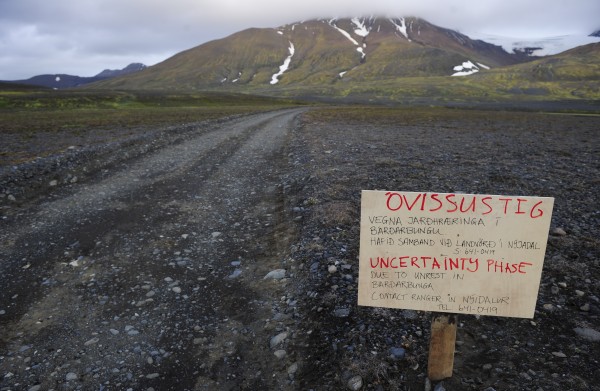Scientists Discover How the Earth's Crust is Formed
| Dino Lirios | | Dec 16, 2014 10:24 AM EST |
(Photo : Reuters) Confirming fears, Iceland's Bardabunga volcano is now actively erupting.
Scientists have gained more insight into how the Earth's crust forms from data obtained by a research team that studied an erupting Icelandic volcano.
Last August, a swarm of about 1,600 earthquakes with magnitudes of 4.5 hit Iceland in 48 hours.
It was an indication that the second highest mountain in Iceland and buried under the Iceland's Vatnajokull ice cap, Barðarbunga, was about to erupt. Since then, people have been evacuated due to the continual eruption of the volcano.
Like Us on Facebook
Scientists, however, have observed how the Earth's crust forms because of this phenomenon. They observed that molten rock forms vertical sheet-like features known as dykes. These dykes force surrounding rocks apart.
Professor Andy Hope from the Center of Observation and Modelling of Earthquakes, volcanoes and Tectonics (COMET) is the co-author of the study.
He explains that new crust forms whenever two tectonic plates move away from each other. This mostly happens beneath the ocean where it's hard to observe.
In Iceland, this happens beneath dry land. The events leading to the eruption in August 2014 are the first time such a rifting episode has occurred there and been observed with modern tools, like GPS and satellite radar.
The dyke then grows in segments and breaks through from one to the next by the build-up of pressure.
This spectacle explains how focused upwelling of magma under central volcanoes is redistributed over large areas of land, effectively creating a new upper crust at divergent plate boundaries.
Apart from the dykes, the team also found ice cauldrons or shallow depressions in the ice with circular crevasses where the base of the glacier has been melted by magma.
From these findings, scientists discovered why magma from a volcano travels in such a roundabout path into the Earth's crust.
TagsCrust, Formed, Baroarbunga, Iceland
©2015 Chinatopix All rights reserved. Do not reproduce without permission
EDITOR'S PICKS
-

Did the Trump administration just announce plans for a trade war with ‘hostile’ China and Russia?
-

US Senate passes Taiwan travel bill slammed by China
-

As Yan Sihong’s family grieves, here are other Chinese students who went missing abroad. Some have never been found
-

Beijing blasts Western critics who ‘smear China’ with the term sharp power
-

China Envoy Seeks to Defuse Tensions With U.S. as a Trade War Brews
-

Singapore's Deputy PM Provides Bitcoin Vote of Confidence Amid China's Blanket Bans
-

China warns investors over risks in overseas virtual currency trading
-

Chinese government most trustworthy: survey
-

Kashima Antlers On Course For Back-To-Back Titles
MOST POPULAR
LATEST NEWS
Zhou Yongkang: China's Former Security Chief Sentenced to Life in Prison

China's former Chief of the Ministry of Public Security, Zhou Yongkang, has been given a life sentence after he was found guilty of abusing his office, bribery and deliberately ... Full Article
TRENDING STORY

China Pork Prices Expected to Stabilize As The Supplies Recover

Elephone P9000 Smartphone is now on Sale on Amazon India

There's a Big Chance Cliffhangers Won't Still Be Resolved When Grey's Anatomy Season 13 Returns

Supreme Court Ruled on Samsung vs Apple Dispute for Patent Infringement

Microsoft Surface Pro 5 Rumors and Release Date: What is the Latest?










